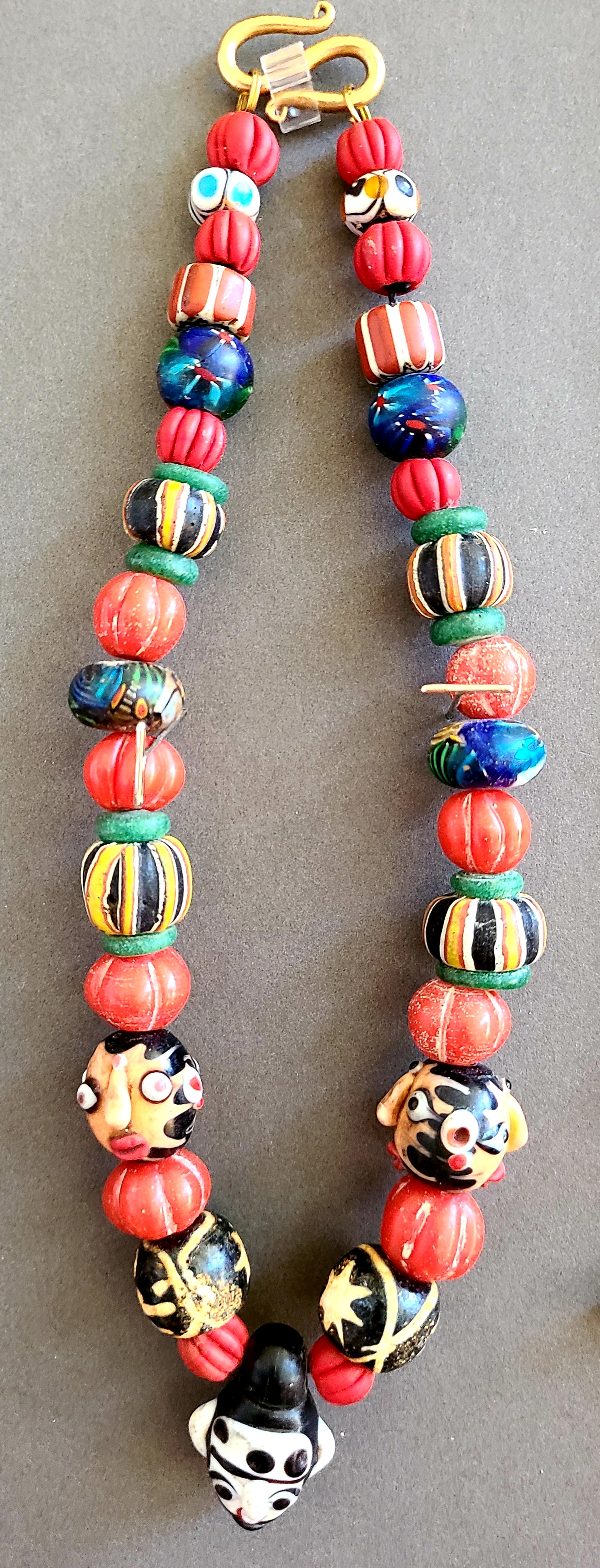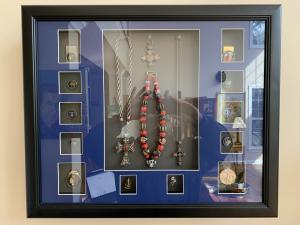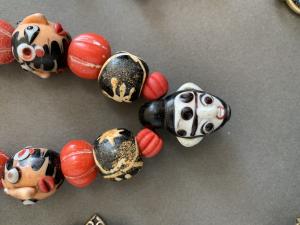Burmese necklace
Unknown
Jewelry, Watches and Coins
A Burmese necklace with hand-painted ivory and wooden beads with a central ivory piece featuring man's face and secondary pieces depicting figures with two faces, birds, eyes, stars and nature.
The necklace presumably represents the traditional Burmese marionette puppetry called Yoke thé that dates from the 15th century. Puppetry is among the most ancient and important Burmese forms of art, therefore it’s common for necklaces and jewelry to symbolize it.
The performances of Yoke thé take on a spiritual significance. They’re based on stories from the Jataka, the sacred texts that recount stories of Buddha’s past lives, as well as historical legends and folktales. When first introduced in Burma, marionette productions were exclusively for royals. In the Burmese ancient days, puppeteers were asked by the king to play the show as an indirect way of warning the court and royal family members about their misbehaviors cleverly with a storyline of similar situation. Later they became available to everyone thus playing a significant role in the Burmese culture. Puppet shows play more than just a mere entertainment role but are also used to share knowledge on history, traditions, and social customs across the regions.
Yoke thé puppet play includes 27 characters. The central piece of the necklace with a man's face most likely represents the king (Bayin, or Min), or the prince (Mintha) - major characters of Yoke thé theater, as three dots on the head of the figure presumably represent the crown, a symbol of royalty. Most characters of Yoke thé theater have white-painted faces with big eyes and bright red lips with the facial features outlined with the black paint. The central piece of the necklace looks exactly the same.
In traditional Burmese puppet theatre the characters can be not only humans, but also animals, or mythical beings. The bead with a figure resembling a bird close to the central piece of the necklace is most likely the mythical bird Garuda (eagle), one of a number of characters representing the Creation of the World (Himavunta) in Yoke thé shows. In Burmese epics, which was influenced by Hindu-Buddhist beliefs, Garuda is known as Galone, the nemesis of the Nāgas - divine, semi-divine deities.
Beads painted with flowers and landscapes might depict the painted backdrops used in Yoke thé representing forest, the common site of the action.
Most stories of Burmese puppet theater involve celestial beings. The bead with stars might symbolize the stories about them as well as the Creation of the World.
Beads with two-faces figures presumably represent one of the Nats (Spirits) worshipped in Myanmar in conjunction with Buddhism. They are believed to provide safety and prosperity and play a very important role in Burmese culture, customs and traditions.
The performances of Yoke thé take on a spiritual significance. They’re based on stories from the Jataka, the sacred texts that recount stories of Buddha’s past lives, as well as historical legends and folktales. When first introduced in Burma, marionette productions were exclusively for royals. In the Burmese ancient days, puppeteers were asked by the king to play the show as an indirect way of warning the court and royal family members about their misbehaviors cleverly with a storyline of similar situation. Later they became available to everyone thus playing a significant role in the Burmese culture. Puppet shows play more than just a mere entertainment role but are also used to share knowledge on history, traditions, and social customs across the regions.
Yoke thé puppet play includes 27 characters. The central piece of the necklace with a man's face most likely represents the king (Bayin, or Min), or the prince (Mintha) - major characters of Yoke thé theater, as three dots on the head of the figure presumably represent the crown, a symbol of royalty. Most characters of Yoke thé theater have white-painted faces with big eyes and bright red lips with the facial features outlined with the black paint. The central piece of the necklace looks exactly the same.
In traditional Burmese puppet theatre the characters can be not only humans, but also animals, or mythical beings. The bead with a figure resembling a bird close to the central piece of the necklace is most likely the mythical bird Garuda (eagle), one of a number of characters representing the Creation of the World (Himavunta) in Yoke thé shows. In Burmese epics, which was influenced by Hindu-Buddhist beliefs, Garuda is known as Galone, the nemesis of the Nāgas - divine, semi-divine deities.
Beads painted with flowers and landscapes might depict the painted backdrops used in Yoke thé representing forest, the common site of the action.
Most stories of Burmese puppet theater involve celestial beings. The bead with stars might symbolize the stories about them as well as the Creation of the World.
Beads with two-faces figures presumably represent one of the Nats (Spirits) worshipped in Myanmar in conjunction with Buddhism. They are believed to provide safety and prosperity and play a very important role in Burmese culture, customs and traditions.
Height: 18
Width:
Depth:
Bali
Burma
The necklace is presumably made from ivory and wooden beads. All beads are hand-painted and beads depicting human faces are also glazed.
Ivory carving ("sinswe pan pu") developed in Burma out of what the Burmese call "pan pu", woodcarving, which is one of the pan sai myo, or "ten arts". It is not uncommon for Burmese art objects to be made of both wood and ivory.
In Burma only males are taught to carve, as the carvers believe that females do not have the necessary strength. The main tool of the Burmese ivory-carver as well as the wood-carver is the chisel, made of iron with a wooden handle and a hammer-like wooden beater. The stages of creating carved beads and figures include measuring, cutting, drawing, roughout, fine carving, and finishing when the piece is smoothed and polished often using a bamboo soaked in water. Then the beads and figure pieces are painted.


